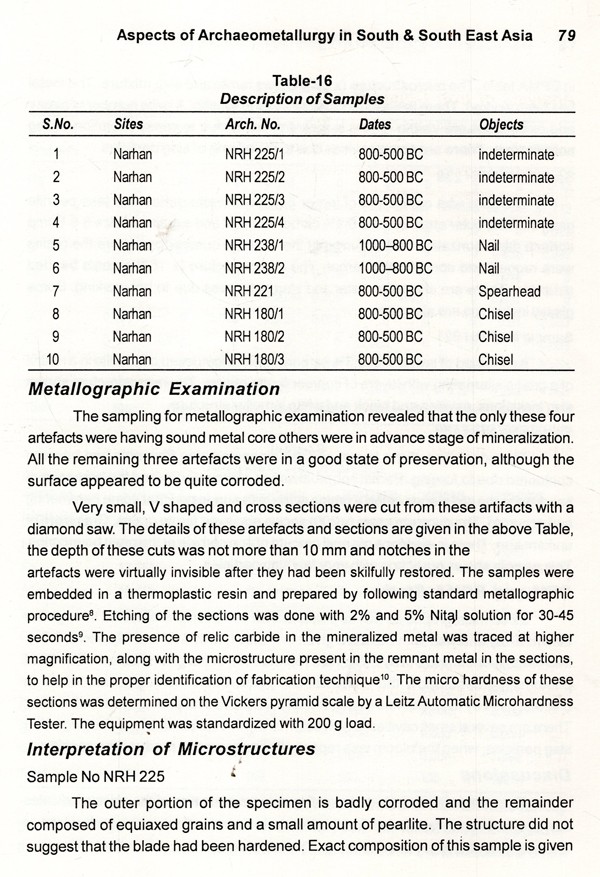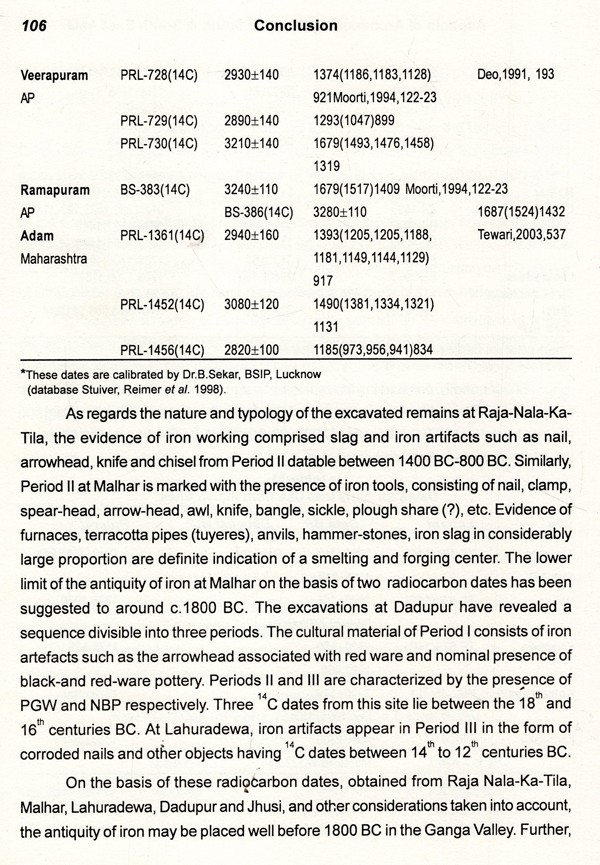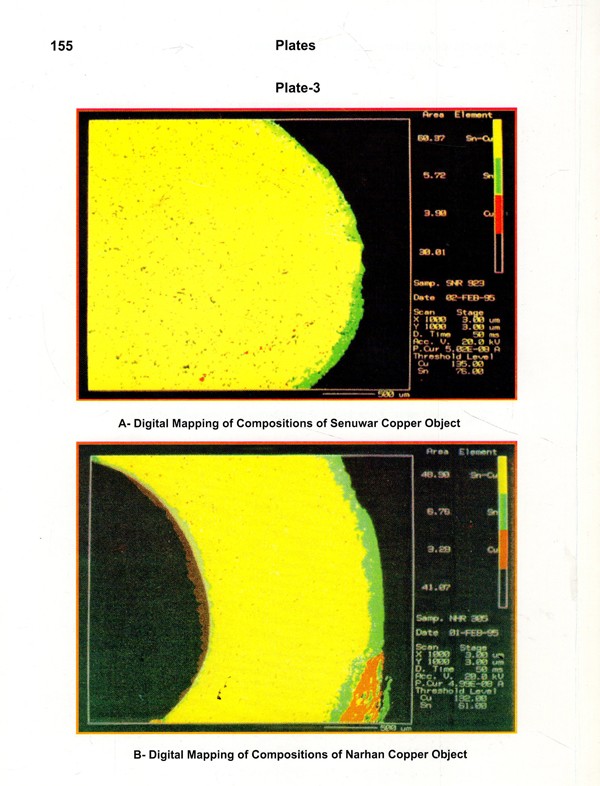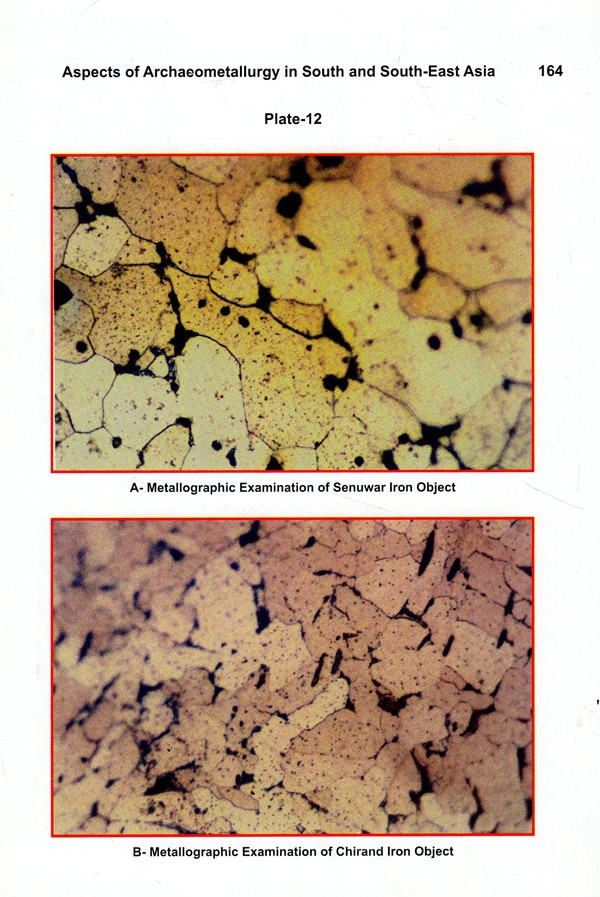
Aspects of Archaeometallurgy in South and South-East Asia (A Study of Metal Objects from North India and Thailand) (An Old and Rare Book)
Book Specification
| Item Code: | UAX072 |
| Author: | Ravindra N. Singh |
| Publisher: | KALA PRAKASHAN |
| Language: | English |
| Edition: | 2007 |
| ISBN: | 8187566841 |
| Pages: | 168 (Throughout Color Illustrations) |
| Cover: | HARDCOVER |
| Other Details | 11.00 X 9.00 inch |
| Weight | 930 gm |
Book Description
Archaeometallurgy is the applicantion of the materials science to archaeological studies. In particular the study of the processing of metals from ore to final artefact, the trade and use of the artefact and the processes involved, its deposition and subsequent corrosion.
The study of metal in archaeology has become increasingly important over the last few decades, providing the archaelogist with information on many aspects of the past, including chronology, trade and technology. In recent years, scientific developments and statistical techniques have contributed still further to the analysis of metals. Aspects of Archaeometallurgy in South and South-East Asia' covers information obtained from practical experience in the field, laboratories and latest researches.
The volume offers a synthesis of the available scientific and archaelogical data on the study of copper and iron objects from nothern India particularly, the Middle Ganga Plain and their relation with South East Asian sites, particularly on the issue of tin. The book examines the most recent research into the quantitative and structural studies of metals.
This will be essential reading studients, researchers, archaeologists and for the historians of technology.
Ravindra N. Singh (b. 1956) is currently Reader in History of Science & Technology in the Department of AIHC & Archaeology at Banaras Hindu University. He is a science graduate with Postgraduation & Doctorate from AIHC & Archaeology, BHU. He also obtained P. G. Diploma in Spectroscopy. Dr. Singh is engaged in archaeological research particularly material studies and field archaeology since last two decades.
Dr. Singh is actively engaged in research projects including, An Ethno-technological study of Iron Metallurgy in Chandauli' (INSA. New Delhi), Archaeological Geography of Ganga Valley' & 'Archaeology of Deccan Routes' (Cambridge University). He is a member of the Indian Research Group to work on the project entitled, From the collapse of Harappan urbanism to the rise of the great Early Historic cities' awarded recently by UKIERI (the British Council).
Dr. Singh is recipient of quite a few prestigious fellowships including the UGCS Indo Soviet Cultural Exchange Fellowship. Moscow (1986), the Nehru Trust Fellowship, London (1994) and The Royal Society, London's Fellowship, Cambridge (2001). He has participated in several national and international conferences and visited a number of countries including USA, UK, Canada, Germany, Netherlands, Belgium,. Italy, France, Israel etc. Recently (2006), he has participated in BUMA VI held at Beijing as a delegate of Indian National Academy of Engineering.
Dr. Singh has published widely in national and international journals of repute. Amongst the monographs, Ancient Indian Glass: Archaeology & Technology (1989), History of Science and Technology during Gupta Period with S. Saran (1994), Reconstructing History (three volumes as Jt. Editor with V. D. Mishra) (1998). His forthcoming publications are Chandauli. Prehistory to History and Characterisation of Metal objects from Middle Ganga Plain.
The present monograph is an attempt to summarise the results of my experiments on the copper and iron samples from a few archaeological sites of middle Gangetic plains in India and from Bon Don Ta Phet, a bronze age site in central Thailand initially during the course of my studies of archaeometallurgy at the Wolfson Laboratory Institute of Archaeology, London in 1994-95 and in the Department of Archaeology University of Cambridge during 2001-2004 and finally in the Laboratory for Scientific Studies in Archaeology, Department of AIHC & Archaeology, Banaras Hindu University. Although the objects studied are not the representative of the entire collections of their respective sites but the importance of the samples selected is because of their occurrence from well stratified levels of the scientifically excavated archaeological sites having C dates and thus valuable for reconstructing the history of technology in general and metal technology in particular. The copper samples having the dates between c. 1800 BC to 2nd century AD and the dates of iron sample range between 1000 BC to 2nd century AD.
Since there no systematic studies of archaeometallurgy were available in India, it has been suggested by my collaborators, Dr. Ian C. Glover and Dr. John F. Merkel at the Institute of Archaeology, London and Prof. M.K.Jones at the Department of Archaeology, University of Cambridge, that I concentrate on studying-the principles of archaeometallurgy and conservation of metallic artefacts which include, archaeology of metals, ore mineral identification, ore petrography, economic mineral deposits and geological maps, determinative mineralogy, mining and ore benefication, ancient ore source, extractive metallurgy, physical metallurgy, traditional metalworking techniques, decorative metalworking in antiquity, analytical studies using various instruments, etc.
Archaeometallurgy is concerned with the techniques and processes involved in metal production, which reflect man's growing knowledge and control over the world around him. Archaeometallurgical studies were initially focused on the chemical and metallographical analysis of artefacts in order to determine their composition and the methods used in their manufacture. The focus then shifted to other materials and their archaeological contexts, processing by-products such as slag, matte, furnace linings and furnace bottoms, crucibles, moulds, cupels and tuyeres which are often more abundant on site than metal. Thus the field of study has been enlarged beyond metallurgy to an interdisciplinary undertaking of materials science, archaeology, and material culture. Simultaneously with this shift in focus came the application of newly developed instrumentation, which supported a parallel shift in methodology from one emphasising chemical analysis and microstructures to one of materials characterisation, emphasising properties and performance.>p> Archaeometallurgy is an increasingly visible aspect of archaeometric research, which goes beyond formal typological classification of artefacts to expand the interpretative quality of archaeological data related to the production, and consumption of metal. Typically such studies involve the integration of archaeology with a variety of disciplines, including ethnography, geology, historical research, and material science. Largely material scientists who expressed an interest in the historical development of their discipline pioneered Archaeometallurgical studies. The history of technology is and will continue to be an important goal of research, but it is by no means the only one. Many of the archaeometallurgical studies have been influenced by the work of Ursula Franklin (1982) and Cyril Stanley Smith (1971, 1982), who have stressed that the scientific study of materials not only provides an understanding the history of technology but can also reveal the conscious choices and values of a given technology's producers and consumers. The later understanding provides a research link with the goals of anthropological archaeology.
An important contribution of material science approaches to the analysis of metallurgical data has been the study of the expression in technology of the interaction between contemporary culture groups organised along different social and economic levels.
Over the past few decades, archaeometallurgy has been extended to fieldwork, including the study of the location of ore sources, ancient mining methods, the proximity of mines to production sites, ore beneficiations, the processes involved in extracting the metals from their ores, the scale of production and the extent of trade in ore, metal, and finished artefacts.
**Contents and Sample Pages**


















